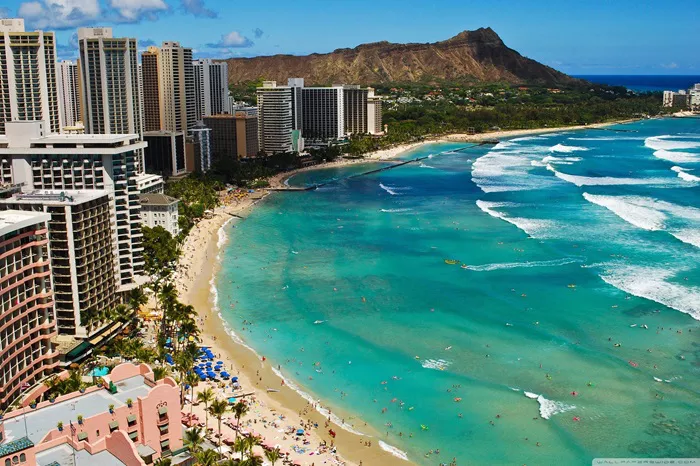Waikiki Beach in Honolulu, Hawaii, is one of the most famous beaches in the world. With its golden sands, warm waters, and stunning views of Diamond Head, it’s a dream destination for travelers. But is it safe to swim here? The answer is generally yes, but there are important things to keep in mind to ensure a safe and enjoyable experience.
General Safety
Waikiki Beach is a popular swimming spot, and for good reason—it has calm waters, designated swimming areas, and lifeguards on duty. However, safety depends on conditions, personal awareness, and following local guidelines. Always check water conditions before entering, be aware of your swimming ability, and respect safety warnings posted on the beach.
Lifeguard Presence
Lifeguards are stationed at multiple points along Waikiki Beach. They are on duty daily from around 9:00 AM to 5:30 PM, though hours can vary slightly by location. Lifeguard towers are clearly marked, and their presence ensures quick responses to emergencies. If you ever feel unsafe or unsure about conditions, ask a lifeguard for advice.
Lifeguard Tower Locations
Kuhio Beach: One of the most family-friendly spots with calm waters.
Queens Beach: Popular for bodyboarding and near Kapiolani Park.
Duke Kahanamoku Beach: Located at the west end of Waikiki, close to Hilton Hawaiian Village.
Water Conditions
The waters of Waikiki Beach are typically calm, especially near shore. However, conditions can change depending on the season.
Summer (May – October): The ocean is usually calm with smaller waves, making it ideal for swimming.
Winter (November – April): Larger swells occur, particularly near the outer reef. Beginners should be cautious, as waves can be stronger.
Afternoon Winds: Trade winds can cause choppier water later in the day.
Tides: Low tide is best for safe swimming, while high tide can bring stronger currents.
Check daily surf and tide reports to stay informed before heading into the water.
Rip Currents
Rip currents can occur in Waikiki, especially near rocky outcrops and where waves break unevenly. These currents can pull swimmers away from shore. Here’s how to identify and deal with them:
How to Spot a Rip Current
Water appears darker with fewer waves.
The water may move swiftly away from shore.
Foam or debris floating outward in a channel.
What to Do if Caught in a Rip Current?
Stay calm. Don’t panic or fight the current.
Swim parallel to shore. Rip currents are narrow; once you escape, swim back.
Float or tread water if too tired to swim.
Wave for help if you cannot escape.
Marine Life
Waikiki Beach is home to beautiful marine life, but some creatures require caution.
Common Marine Animals
Jellyfish: Box jellyfish can appear 8-10 days after a full moon. Their stings can be painful.
Sea Urchins: Found in rocky areas. Avoid stepping on them.
Eels and Reef Fish: Generally harmless but should not be disturbed.
Portuguese Man O’ War: Sometimes found in the water. Avoid touching them.
If stung by a jellyfish or man o’ war:
Rinse with vinegar (not freshwater).
Remove tentacles with a credit card or similar object.
Seek medical attention if symptoms worsen.
Safety Tips
To make the most of your swim at Waikiki Beach, follow these essential safety tips:
Swim in designated areas. Lifeguards monitor these spots for safety.
Never swim alone. A buddy can assist in emergencies.
Stay hydrated and wear sunscreen. Sun exposure can cause dehydration.
Avoid swimming at night. Poor visibility increases risks.
Be cautious after rain. Heavy rains can cause runoff, reducing water quality.
Health Precautions
Water quality at Waikiki Beach is generally good, but occasional advisories are issued for high bacteria levels, especially after heavy rain.
Check water quality reports from the Hawaii Department of Health before swimming.
Avoid the water for 24-48 hours after heavy rains to reduce exposure to pollutants.
Emergency Procedures
If an emergency arises:
Signal for help. Wave both arms above your head.
Call 911 if you have a phone.
Seek the nearest lifeguard station for immediate assistance.
Know where first aid stations are located. They are near lifeguard towers.
Visitor Reviews and Testimonials
Many visitors have positive experiences swimming at Waikiki Beach. Here are a few real-life perspectives:
“The water was so warm and clear. The waves were gentle, and we felt really safe with lifeguards nearby.” – Anna R., California
“We saw some jellyfish signs posted, but lifeguards told us where it was safe to swim. Great experience overall!” – Jake M., Texas
“There were some rip currents near the edges of the beach, but the main swimming area was calm. Just be aware of conditions!” – Laura S., Australia
Conclusion
Waikiki Beach is generally a safe place to swim, thanks to its calm waters, lifeguard presence, and well-maintained conditions. However, being aware of potential risks—such as rip currents, jellyfish, and occasional poor water quality—ensures a safe and enjoyable experience. By following safety guidelines, checking water conditions, and swimming responsibly, visitors can make the most of this iconic beach.
For the best experience, grab a coffee from a nearby café, enjoy the sunrise over the Pacific, and take a refreshing swim in Waikiki’s legendary waters!

